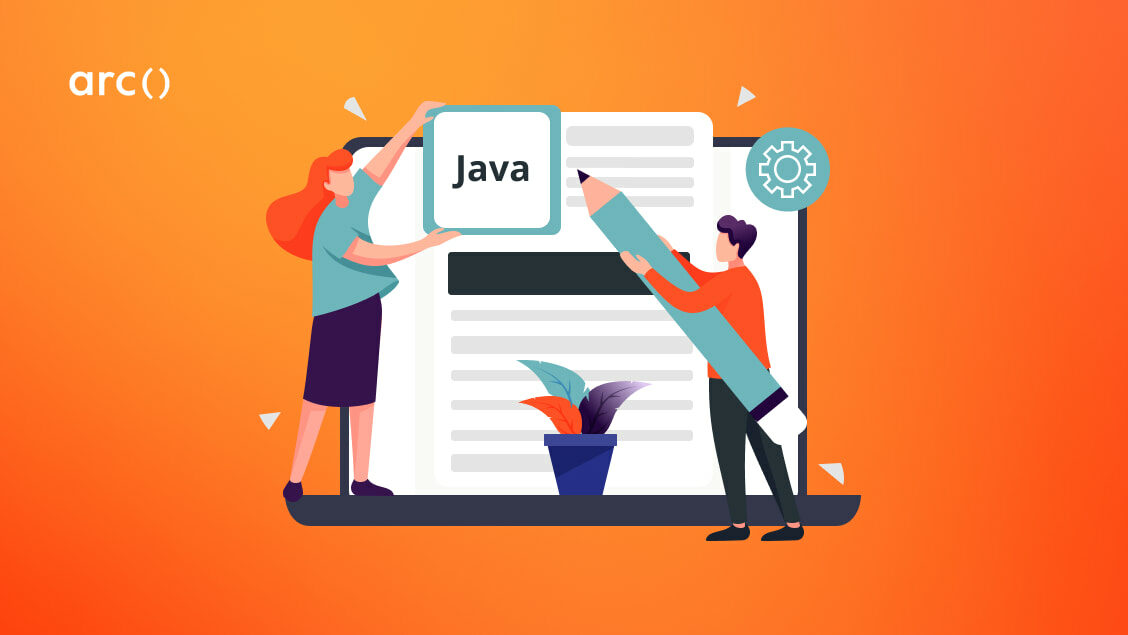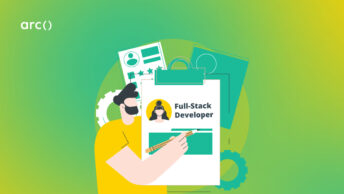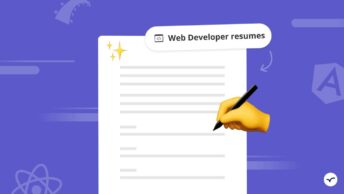Are you searching through Java developer jobs and ready to apply?
Your technical expertise with multithreading and memory management on a JVM aren’t the only things affecting your chances of landing the position you want.
It’s just as much about presenting yourself to recruiters in the right way — and writing a great Java developer cover letter is a big part of that. Fortunately, we’re here to teach you how to do it properly and without much fuss.
Java Developer Cover Letter 101
It’s safe to say that writing cover letters and filling out resumes don’t often make it into the top 10 best parts of a Java software development career.
However, a cover letter is often a crucial part of your candidacy, especially if you plan on looking for remote jobs. Along with the email you send off and the resume you attach, it becomes the first impression you make on HR managers and technical recruiters.
Our number one piece of advice when writing a Java developer cover letter: always recompile. As a general-purpose programming language, Java’s goal is to allow programmers to “write once, run anywhere” (WORA). But, don’t try this on your cover letter! Recruiters always prefer reading a tailored version over a generic one.
The Java cover letter is usually sent out with your resume and your developer portfolio, and it gives you a chance to provide recruiters with a more personal view of your professional experience. Make no mistake — if you don’t want to be overlooked by recruiters, a great cover letter is essential.
Before we get into our step-by-step guide, take a look at this sample cover letter for Java developers we’ve included for some inspiration!
Read More: How to Write a Great Thank-You Email After an Interview
Sample Java Developer Cover Letter
Here’s a great Java developer cover letter example to give you an idea of how a proper one should look and be structured. But remember, as we said above, make sure the content is written for the specific company and job position you’re applying to!
Stephanie Grimm Full Stack Java Developer 4227 15th Ave. New York, NY 10019 March 2, 2022 Deborah May Senior Technical Recruiter Digitly 914 Cliffside Dr. Binghamton, NY 13901 Dear Deborah: After coming across Digitly's senior full stack Java developer job description on LinkedIn, I was immediately sure I wanted to apply. With my master’s degree in computer science, more than six years of software development expertise, and recent experience with Java in the fintech industry, I believe I could make a great fit! Over the past six years, I’ve amassed extensive experience in Java development while building building full stack web applications with foundations in Java 8+ with Spring Boot, Angular, and DB2. I have in-depth, hands-on knowledge of Hibernate, RDBMS, SQL, object oriented programming concepts, event-driven systems (Kafka), and containerized applications (Docker/Kubernetes). On a day-to-day basis, I currently have senior-level responsibilities, including leading design workshops, performing code reviews, supporting production, and liaising with product owners and other stakeholders. Given how well my background and skill set match what you're looking for at Digitly, I think I am a strong possible candidate. I’d truly appreciate the chance to speak with you further on the senior full stack Java developer role at Digitly. Thanks in advance for considering my application, and I look forward to hearing from you! Sincerely, Stephanie Grimm
How to Write a Java Developer Cover Letter
Now you’ve seen what a great cover letter example looks like, it’s time to write your own!
Here’s a quick guide on writing a Java developer cover letter:
1. Preparations before writing
Don’t just start writing, even if you’ve carefully analyzed the cover letter sample included above.
First, locate the original Java developer job description you’re applying to and keep that open. You’ll need this as a reference because your goal is a custom-tailored cover letter specific to this particular job ad.
After this, do some research on the company you want to work for — their industry, niche, current and past projects, values, short-term and longer-term goals, etc. This will you customize the content of your Java developer cover letter for this specific company.
The best cover letters are generally not too long. Stick to three or four paragraphs. Keep your cover letter short and sweet, and focus on putting your past software developer experience into the context that this new company and engineering team can get behind.
As for the cover letter format, you could send it as the body of your application email with the resume included as an attachment. But, for the most part, it’s better to include the cover letter as a PDF attachment, as well.
Read More: When Can You Stop Calling Yourself a “Junior” Software Developer?
2. The cover letter header
The first thing you’ll be tackling is the cover letter header, where you’ll include the sender’s information (yours), the date of writing, and the recipient’s information.
Use the standard business letter formatting, as we’ve shown you in the sample Java cover letter above. Alternatively, you can stick to the same template you’ve used for your Java resume for a cohesive visual presentation.
No need to include absolutely everything, though; you’ve got your resume for that. All you need really is your full name, your professional title or branding statement (similar to your LinkedIn headline), and your address.
Then, include a line break and write today’s date after it. Follow that with another line break. Finally, the recipient’s details. Start by addressing someone specifically at the company. Their name first, their official title below that, and then the company’s name and address below that.
3. Salutations and introductions
Now that you’re done with your cover letter heading area, it’s time for some actual writing! First off is writing a salutation and an introductory paragraph.
For the salutation, it’s always best to take a personal approach whenever possible. If you know the name of the hiring manager or recruiter, address them directly. You’ll leave a much more memorable impression than someone using a generic greeting like To whom it may concern.
Next is your opening paragraph. If you’re wondering how to start a cover letter for Java developers, try to achieve these things:
- Inform them which specific role you’re applying for (there could be multiple Java developer jobs available)
- Highlight which aspects of this specific job made you apply
- Introduce yourself as a talented and able candidate
- Compel the recruiter to keep reading and learn more about your work experience.
Read More: Software Developer vs Engineer vs Programmer (& More Related Titles)
4. The body of your Java developer cover letter
Now it’s time for the main part of your cover letter, the body area.
When you’re writing a mid-level or senior Java developer cover letter, use this area to describe some career highlights. If you’re a self-taught developer or you’re just starting out, showcase your personal projects, technical skills, and your education. No matter what your experience level as a Java developer, use the job description to formulate your background, skills, and accomplishments in a way that fits what they’re looking for.
The body of your cover letter for this kind of position should show:
- Why you are an outstanding candidate for this job;
- What kind of qualifications you have and how they’re relevant;
- Which of your accomplishments illustrate your quality as a candidate;
- Solid metrics like dollar amounts or percentages that show what kind of value you’ve brought to previous employers.
Share details about your previous projects to entice technical leads, and help recruiters understand what makes you the perfect Java developer for their company. You can do this by connecting the dots between your previous projects with the job description for the position you’re applying to.
5. The end of the cover letter
We’ve already reached the end!
Wrap up by simply thanking the tech recruiter or HR manager for considering your application. Ask them to contact you with any further steps or questions they might have just to end the cover letter with a call to action.
Finally, end your Java dev cover letter with a simple Sincerely, followed by your full name. There’s not much else to it than that!
Read More: How to Become a Software Engineer: Education, Steps & Tips for Success
Top Java Developer Cover Letter Tips
As you’ve probably noticed, writing a Java developer cover letter isn’t so difficult once you get the hang of what it should include.
While following our guide and sample cover letter is pretty straightforward, here are some great tips and best practices to keep in mind!
1. Don’t repeat resume information
For most job seekers, the difference between the purpose of their software developer resume and their cover letter can be confusing. However, understanding the subtle differences is vital if you don’t want to repeat information unnecessarily — and you really don’t.
Your resume should be two pages long at most, and it should be your basic ticket to get started with the hiring process. It’s not supposed to contain your whole life (or rather, work) story. On the other hand, your Java developer cover letter is there for a more personal touch. It gives you some more room to discuss specific relevant experiences or achievements related to the job description.
2. Use keywords
While writing your cover letter, make sure to sprinkle a couple of vital keywords that will attract recruiters and make your letter seem more professional. These keywords depend on the specific Java job you’re applying for. For Java developers, some of those are:
- PostgreSQL
- Spring
- Java
- MySQL
- PL/SQL
- MVC
- Scrum
- JUnit
- OOP
- Agile
- HTML, CSS, JavaScript
- jQuery
- XML & JSON
- Abstract classes and interfaces
- Java Virtual Machine (JVM)
- Hadoop
- SOAP/REST
- GIT, SVN, JIRA
- GRUNT & GULP
- Bootstrap
However, don’t be so tunnel-focused on your technical skills that you neglect your soft skills! After all, joining a new team requires great communication and strong interpersonal skills. On distributed teams, you may want to highlight your intercultural communication skills, self-motivation, and remote collaboration abilities.
Finally, and particularly for senior or lead Java developer positions, you may want to showcase your analytical skills, ability to solve problems effectively, leadership skills, time management, and more.
Read More: 12 Common Mistakes Keeping You From Landing Your First Developer Job
3. Quantify your results
When discussing what kind of value you’ve brought to your previous employer, be as specific as possible. Include some metrics with hard numbers while talking about your previous projects, and your results will seem more tangible to any recruiters reading your cover letter.
This will also set you apart from other candidates, because most of them will just use this portion of the letter to list out their previous Java developer duties and responsibilities. However, hiring managers like candidates that understand the impact their roles have had on overall projects — and they especially like candidates that use numbers to verify their claims.
4. Do research on the company
We’ve already mentioned this in passing, but make sure you do enough research on the company before you start writing your cover letter. Show them you’re not just interested in having any job — you’re inspired by what this particular company does.
That also entails knowing about who they are, what their current objects and obstacles are, their company values and culture, and so on. This further allows you to tie in your own skills and experience with the job description and position yourself as the perfect applicant to help them solve their current shortcomings.
Read More: How to REALLY Get a Job as a Self-Taught Developer
Wrapping Up
While your Java developer resume can showcase your technical skills “on paper,” the cover letter gives you the chance to make your case for how you’d bring unrivaled value to the new company and software engineering team. It’s also a great opportunity to show off some of your actual personality, as opposed to the boring technical bullet points covered in the Java resume.
Unfortunately, plenty of both junior and senior Java developers find writing a cover letter challenging. You need to explain your previous work experience to non-technical recruiters in an understandable way, while also being compelling to engineering leads that might read your cover letter at later stages of the recruitment process.
While this balancing act may not seem easy at first, don’t worry — if you followed our guide on what to include in a cover letter for Java developer positions above, you’re well on your way to landing that job interview!
That’s pretty much all you need to know about writing a Java developer cover letter, and we hope our guide, tips, and examples have helped you! If you have any questions or feedback, feel free to write to us in the comments below, and, as usual, thanks for reading 🙂











